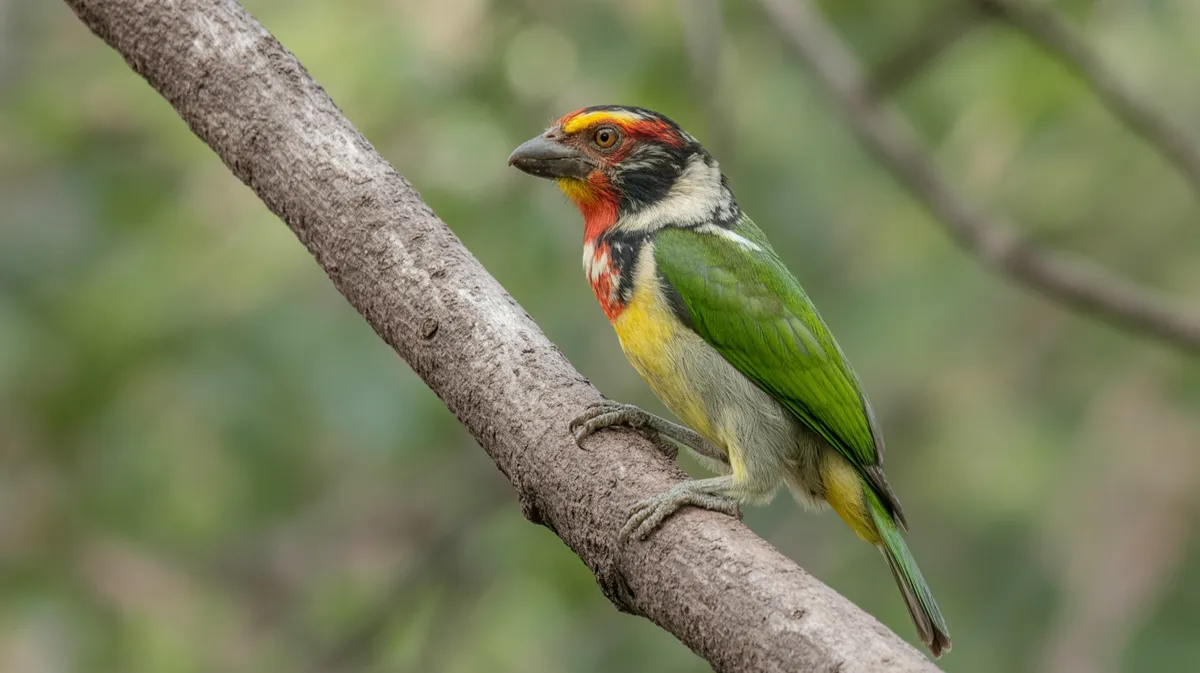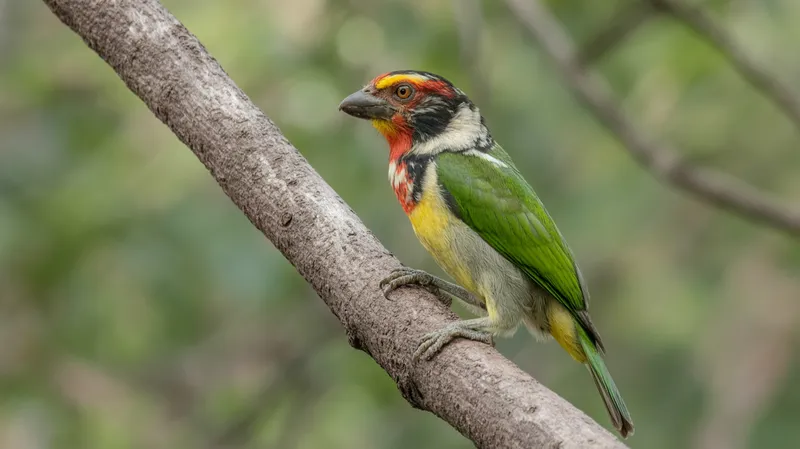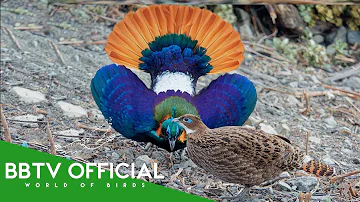
African Barbet
Lybiidae

Meet the African Barbet
Barbets are plump, colorful birds found throughout tropical regions of Africa and Asia, known for their stout bills and bristle-fringed faces. Members of the family Lybiidae, African barbets are particularly noted for their bright plumage, which often includes striking reds, yellows, and greens. They primarily inhabit forests and woodland environments, where they excavate nest holes in trees. Barbets are vocal birds, producing distinctive, repetitive calls that can be heard over long distances. Their diet consists mainly of fruit, but they will also eat insects and other small animals.
Classification
Bird
Habitat
Woodlands and forests
Diet
Omnivore
Lifespan
6-10 years
Conservation
Least Concern
Weight
30-110 grams
📖Fascinating Facts
Fruit Lovers
Barbets primarily eat fruit, especially figs, but they will also catch insects, making them important for both seed dispersal and insect control.
Tree Carvers
They use their strong beaks to carve out nest holes in dead or decaying wood, often returning to the same site year after year.
Distinctive Calls
Barbets are known for their loud, rhythmic calls, which often sound like a repeated 'pop-pop-pop' and serve to mark territory and attract mates.
📋Detailed Description
African barbets (family Lybiidae) are medium-sized, robust birds characterized by their large heads, short necks, and stout, conical bills adorned with prominent bristles at the base. Adult barbets typically range from 9 to 22 cm in length, with weights varying from 20 to 110 grams depending on the species. Their plumage is often a vivid combination of reds, yellows, greens, and blacks, with some species exhibiting striking patterns or sexual dimorphism. The bill's bristles are thought to aid in handling fruit and in nest excavation. Barbets possess zygodactyl feet (two toes facing forward, two backward), facilitating strong grips on branches and vertical surfaces. Most species are arboreal, spending the majority of their time in the forest canopy or woodland edges. They are cavity nesters, excavating holes in dead or decaying wood using their powerful bills. Vocalizations are a key aspect of their behavior; their repetitive, far-carrying calls are used for territory defense and mate attraction. African barbets are generally sedentary, maintaining year-round territories, and are most active during the early morning and late afternoon.
💡 Did you know?
Despite their bright colors, barbets can be surprisingly difficult to spot as they often remain motionless among dense foliage while calling.
🔬Research & Sources
Wikipedia Summary
Lybiidae is a family of birds also known as the African barbets. There are 44 species ranging from the type genus Lybius of forest interior to the tinkerbirds (Pogoniulus) of forest and scrubland. They are found throughout sub-Saharan Africa, with the exception of the far south-west of South Africa.
Last Modified: 3/26/2025
🎭Behavior & Social Structure
African barbets are primarily diurnal and exhibit a mix of solitary, paired, and small group behaviors depending on the species. They forage methodically through the canopy and mid-levels of trees, using their strong bills to pluck fruit or probe for insects. Their diet is dominated by figs and other soft fruits, but they also consume beetles, caterpillars, ants, and occasionally small vertebrates. Barbets play an important ecological role as seed dispersers, passing seeds through their digestive tract and excreting them away from the parent tree. Social interactions include mutual preening, vocal duets (especially in Lybius species), and coordinated territorial displays. Some species, such as tinkerbirds (Pogoniulus), are known for their persistent, metronomic calls, while others engage in complex antiphonal singing. Barbets are territorial and will aggressively defend nesting sites from conspecifics and other cavity-nesting birds.
👶Reproduction & Life Cycle
Breeding seasons vary geographically but often coincide with the onset of the rainy season, when food is abundant. African barbets are monogamous, forming long-term pair bonds. Both sexes participate in excavating nest cavities, which are typically located 2–10 meters above ground in dead wood or occasionally in termite mounds. Clutch size ranges from 2 to 5 eggs, which are white and glossy. Incubation lasts 13–17 days and is shared by both parents. After hatching, both adults feed the chicks with regurgitated fruit and insects. The nestling period is about 24–35 days, after which fledglings remain dependent on parents for several weeks. In some genera (e.g., Lybius), cooperative breeding has been observed, with helpers assisting in feeding and defending the nest.
🛡️Adaptations & Survival
African barbets have evolved several adaptations for their frugivorous and cavity-nesting lifestyles. Their stout, chisel-like bills and cranial musculature allow them to excavate nest holes in hard wood. The bristle-fringed base of the bill may help protect the face from debris and aid in manipulating slippery fruits. Zygodactyl feet provide stability when clinging to vertical surfaces. Their vivid plumage may serve as a signal in mate selection and territorial disputes. Barbets' digestive systems are adapted to process large quantities of fruit, with rapid gut transit times facilitating efficient seed dispersal. Their loud, repetitive calls are an adaptation for communication in dense forest environments.
📚Research Sources
🎨Cultural Significance
African barbets are not widely featured in folklore or traditional symbolism compared to some other African birds, but their vibrant colors and distinctive calls make them familiar to local communities. In some regions, their persistent vocalizations are used as natural indicators of seasonal changes or as cues for agricultural activities. Barbets are occasionally depicted in local art and crafts, and their presence is valued by birdwatchers and ecotourism operators. There are no significant records of barbets being used in traditional medicine or as food.
🔬Recent Research & Discoveries
Recent molecular phylogenetic studies have clarified the relationships within Lybiidae and between African and Asian barbets, supporting the family's separation from the Asian Megalaimidae. Ongoing research focuses on the ecological roles of barbets as keystone seed dispersers and their responses to habitat fragmentation. Studies on vocal behavior have revealed complex duet and antiphonal calling patterns, with implications for understanding avian communication and social structure. Conservation research is increasingly examining the effects of land-use change on barbet diversity and population dynamics. Notably, the genus Trachyphonus (e.g., the Crested Barbet) has been studied for its adaptability to urban and suburban environments.
🎥Wildlife Videos

The Bearded Barbet: A Colorful African Avian Wonder
When we think of the vast and diverse avian species across the globe, few can rival the visual appeal and distinctive ...
Sweet Nature Vibes - Animals

An Adventure Through Africa in 4K | BBC Earth
Go on your very own wildlife safari, and experience the incredible animals of Africa in stunning 4K UHD. Watch as lions take down ...
BBC Earth

30 Most Beautiful Creatures On Earth (Order Galliformes) | Wildlife Documentary | BBTV Official
In the heart of the world's most remote forests and rugged highlands, where mist lingers over ancient trees and the wilderness ...
BBTV Official

The Secret Lives of Birds and Their Aerial Feats | Full Documentary
We envy birds their mastery of the air, watching them enjoy the freedom of a 3 dimensional space. Flight allows them to get to hard ...
Free High-Quality Documentaries

Animals of Africa - HD Documentary - David Attenborough
A captivating insight into the lives of animals in Africa. Narrated by the one and only Sir David Attenborough. Thanks for watching ...
Bruno Bruno

A Journey Through the Magical Wildlife of Chile | Full Documentary
An intimate and classic journey through this wild country. We witness magical moments of nature, from a cougar mother playing ...
Free High-Quality Documentaries
🌍Habitat Information
The African Barbet typically inhabits Woodlands and forests environments. African Barbets have adapted to their environments with specialized features and behaviors.
Primary Habitat:
Woodlands and forests
More detailed habitat information will be available soon.
🛡️Conservation Status
The African Barbet is currently classified as Least Concern. Conservation efforts are crucial for preserving this species for future generations.
Common Threats:
- 🏠Habitat loss and fragmentation
- 🌡️Climate change impacts
- 🎯Hunting and poaching
- 🏭Human-wildlife conflict
⚠️Threats & Conservation Challenges
While most African barbet species are currently listed as Least Concern by the IUCN, several face localized threats. Habitat loss due to deforestation, agricultural expansion, and logging is the primary challenge, particularly for forest-dependent species. Some species with restricted ranges or specialized habitat requirements are more vulnerable to fragmentation. Competition for nesting sites with other cavity-nesters, such as woodpeckers and starlings, can also impact breeding success. Climate change may alter fruiting patterns and food availability, posing additional risks. Despite these challenges, many barbet populations remain stable, in part due to their adaptability and tolerance of secondary growth and human-modified landscapes.
🔬Scientific Classification
Scientific Name
Lybius spp.
Classification Hierarchy
🔍 About Taxonomic Classification
Taxonomic classification is a hierarchical system used by scientists to classify and organize living organisms based on shared characteristics and evolutionary relationships.
The system moves from broad categories (Kingdom) to increasingly specific ones, with each animal's scientific name typically consisting of its Genus and species.
📝Community Notes
Share your observations and insights about the African Barbet with our community of wildlife enthusiasts.
Join Our Community
Sign in to share your observations and connect with fellow wildlife enthusiasts.
Sign In to ContributeNo community notes yet
Be the first to share your observations about the African Barbet!
Explore African Barbet
Select a tab above to learn more about this amazing animal.
📸Photo Gallery
No photos available for this animal yet.
🌟Discover More Wildlife
Continue your journey of discovery with more fascinating animals from our database
